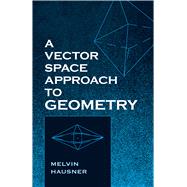
A Vector Space Approach to Geometry
by Hausner, Melvin-

Free Shipping on All Orders!
*excludes Marketplace items.
Buy New
Rent Book
Rent Digital
Used Book
We're Sorry
Sold Out
How Marketplace Works:
- This item is offered by an independent seller and not shipped from our warehouse
- Item details like edition and cover design may differ from our description; see seller's comments before ordering.
- Sellers much confirm and ship within two business days; otherwise, the order will be cancelled and refunded.
- Marketplace purchases cannot be returned to eCampus.com. Contact the seller directly for inquiries; if no response within two days, contact customer service.
- Additional shipping costs apply to Marketplace purchases. Review shipping costs at checkout.
Summary
Author Biography
Table of Contents
1.1 Introduction
1.2 Some Physical Assumptions and Conventions
1.3 Physical Motivations in Geometry
1.4 Further Physical Motivations
1.5 An Axiomatic characterization of Center of Mass
1.6 An Algebraic Attack on Geometry
1.7 Painting a Triangle
1.8 Barycentric Coordinates
1.9 Some Algebraic Anticipation
1.10 Affine Geometry
2. Vector Algebra
2.1 Introduction
2.2 The Definition of Vector
2.3 Vector Addition
2.4 Scalar Multiplication
2.5 Physical and Other Applications
2.6 Geometric Applications
2.7 A Vector Approach to the Center of Mass
3. Vector Spaces and Subspaces
3.1 Introduction
3.2 Vector Spaces
3.3 Independence and Dimension
3.4 Some Examples of Vector Spaces: Coordinate Geometry
3.5 Further Examples
3.6 Affine Subspaces
3.7 Some Separation Theorems
3.8 Some Collinearity and Concurrence Theorems
3.9 The Invariance of Dimension
4. Length and Angle
4.1 Introduction
4.2 Geometric Definition of the Inner Product
4.3 Proofs Involving the Inner Product
4.4 The Metrix Axioms
4.5 Some Analytic Geometry
4.6 Orthogonal Subspaces
4.7 Skew Coordinates
5. Miscellaneous Applications
5.1 Introduction
5.2 The Method of Orthogonal Projections
5.3 Linear Equations: Three Views
5.4 A Useful Formula
5.5 Motion
5.6 A Minimum Principle
5.7 Function Spaces
6. Area and Volume
6.1 Introduction
6.2 Area in the Plane: An Axiom System
6.3 Area in the Plane: A Vector Formulation
6.4 Area of Polygons
6.5 Further Examples
6.6 Volumes in 3-Space
6.7 Area Equals Base Times Height
6.8 The Vector Product
6.9 Vector Areas
7. Further Generalizations
7.1 Introduction
7.2 Determinants
7.3 Some Theorems on Determinants
7.4 Even and Odd Permutations
7.5 Outer Products in n-Space
7.6 Some Topology
7.7 Areas of Curved Figures
8. Matrices and Linear Transformations
8.1 Introduction
8.2 Some Examples
8.3 Affine and Linear Transformations
8.4 The Matrix of a Linear Transformation
8.5 The Matrix of an Affine Transformation
8.6 Translations and Dilatations
8.7 The Reduction of an Affine Transformation to a Linear One
8.8 A Fixed Point Theorem with Probabilistic Implications
9. Area and Metric Considerations
9.1 Introduction
9.2 Determinants
9.3 Applications to Analytic Geometry
9.4 Orthogonal and Euclidean Transformations
9.5 Classification of Motions of the Plane
9.6 Classification of Motions of 3-Space
10. The Algebra of Matrices
10.1 Introduction
10.2 Multiplication of Matrices
10.3 Inverses
10.4 The Algebra of Matrices
10.5 Eigenvalues and Eigenvectors
10.6 Some Applications
10.7 Projections and Reflections
11. Groups
11.1 Introduction
11.2 Definitions and Examples
11.3 The "Erlangen Program"
11.4 Symmetry
11.5 Physical Applications of Symmetry
11.6 Abstract Groups
Index
An electronic version of this book is available through VitalSource.
This book is viewable on PC, Mac, iPhone, iPad, iPod Touch, and most smartphones.
By purchasing, you will be able to view this book online, as well as download it, for the chosen number of days.
Digital License
You are licensing a digital product for a set duration. Durations are set forth in the product description, with "Lifetime" typically meaning five (5) years of online access and permanent download to a supported device. All licenses are non-transferable.
More details can be found here.
A downloadable version of this book is available through the eCampus Reader or compatible Adobe readers.
Applications are available on iOS, Android, PC, Mac, and Windows Mobile platforms.
Please view the compatibility matrix prior to purchase.
